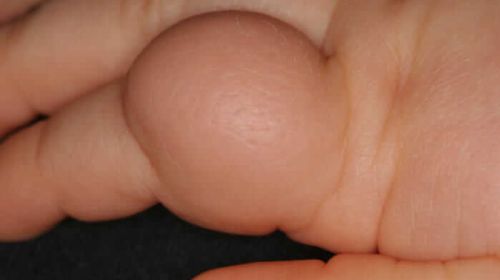Warts are benign skin growths that are caused by an infection with human papillomavirus (HPV). Skin warts can occur on various parts of the body, including on the mucous membrane in the genital area. You can find out what types there are and how warts can be removed here.
- © Getty Images/Niko_Cingaryuk
Quick Overview: Warts (Verrucae)
Definition: Warts are benign, proliferative skin lesions that are caused by human papilloma viruses (HPV).
Species: There are different types of warts, including genital warts, brush warts and flat warts. Molar warts are another viral disease that is not caused by HPV.
Remove warts: Warts can be iced or treated with ointments or solutions such as salicylic acid. Sometimes surgical removal is necessary. Home remedies are not recommended.
Course: In some cases, warts heal on their own. If the immune system is compromised, the skin nodules are often more stubborn.
At a glance:
What are warts?
Warts, medically known as verrucae, are usually benign growths on the skin that are particularly common on the hands and feet. In principle, warts can also appear on many other areas of the body, including the skin and mucous membranes. As a rule, they form where the wart viruses have penetrated the skin.
Because they are caused by a viral infection of the skin with so-called human papilloma viruses (HPV), warts are contagious. There are around 100 different types of viruses that belong to this family and can cause different types of skin warts.
The skin changes are benign and harmless. Those affected are more likely to be bothered by the warts for cosmetic reasons. In the majority of cases, warts do not cause any symptoms. However, some species can also cause symptoms such as itching or pain.
Warts are very common: Studies show that around a third of all children and adolescents between the ages of 6 and 12 have skin warts. In adulthood they occur much less frequently, at around three to five percent.
What types of warts are there?
Experts differentiate between different types, depending on the virus subtype, location and appearance:
Common warts (Verrucae vulgares): They are one of the most common types of warts. Typical symptoms are hemispherical structures that protrude from the skin. Their surface is usually heavily keratinized and fissured. Common warts sometimes appear in groups, but can also occur as a single skin growth. They are often found on the fingers, the edges of the nails or the soles of the feet.
Brush warts (also filiform warts): This is a subgroup of the Verrucae vulgares. They often appear on the eyes or other parts of the face and grow in an elongated, thread-like manner. They often represent an enormous cosmetic problem for those affected.
Plantar warts (verrucae plantares): There are three types of plantar warts: plantar warts, which only occur on the foot, often in the area of the toes, normal skin warts that develop on the sole of the foot, and mosaic warts, which grow like a mosaic on the sole.
Genital warts (also genital warts or condylomas): In men, genital warts tend to occur under the foreskin or on the edge of the glans; in women, they occur on the labia minora, as well as on the cervix and cervix. In both sexes, genital warts can also appear in the anal region. Genital warts usually grow as skin or mucous membrane-colored, cauliflower-like nodules from the area of skin in question. In skin folds they often appear laterally flattened. Multiple genital warts usually form, which are initially small (a few millimeters in diameter). However, they can sometimes grow into large structures.
Flat warts (plane warts): Flat warts are also known as verrucae planae juveniles. They typically occur primarily on the face, but sometimes also on the hands, such as the wrists or the backs of the hands. Children and young people are particularly affected. Flat warts are – as the name suggests – flat and often brownish in pigmentation. Most often, several flat warts form in the affected skin area.
“False” warts
Molluscum contagiosum are not “real” warts. The cause is the Molluscum contagiosum virus (MCV) from the smallpox virus family. Pedunculated warts are so-called soft fibromas: The connective tissue growths are not caused by viruses and are therefore not contagious.
The well-known age-related warts are also not “real” warts: they are not caused by viruses, but are a sign of aging of the skin that occurs in some people, especially over the age of 50. They are often preceded by so-called age spots.
Remove warts – icing, salicylic acid and surgery
In some cases, warts heal on their own and do not require any treatment. Even if a wart does not go away on its own, therapy is not necessarily necessary. However, since warts are perceived as cosmetically disturbing, are contagious and sometimes cause pain, they are often removed.
The method for removing the wart depends on the type, size and number. In some cases, those affected can carry out the treatment themselves, but sometimes medical help is essential.
These treatment options exist
Cryotherapy (icing): When a wart freezes, the wart tissue dies due to the cold. Cryotherapy is often used in dermatology practice: doctors apply liquid nitrogen (-196 degrees Celsius) to the growth. There are usually several treatment intervals. There are now also icing systems for the home.
Surgery: Single, pointed or pedunculated skin warts can be surgically removed under local anesthesia.
Keratolysis: Special substances such as salicylic acid dissolve the top stratum corneum of the skin. For example, plasters or solutions containing salicylic acid are available for keratolysis. The softened horny layer is then removed with a scalpel or a callus plane.
For stubborn warts, a cytostatic drug can also be used, which inhibits the division of skin cells: 5-fluorouracil. The active ingredient is also used in cancer therapy, but is used locally for warts and does not work throughout the entire organism.
Do home remedies help against warts?
Various home remedies are recommended against warts, such as:
- lemon juice,
- vinegar rinses,
- dandelion milk,
- tea tree oil,
- Garlic,
- Onion,
- or own urine.
However, the effect of these methods has not been scientifically proven. Tea tree oil can even irritate the skin cells even further.
Causes: How do warts develop?
Warts are caused by various human papilloma viruses, of which there are hundreds of subtypes. Frequent Wart pathogens are types 1, 2, 3, 4 and 7. Genital warts are mainly caused by subtypes 6 and 11.
These subtypes usually do not lead to malignant cell degeneration, but certain HPV pathogens carry a risk of cancer. The high-risk viruses include HPV 16 and 18. Infection with these viruses is causally linked to cervical cancer in women.
The viruses are transmitted by other people, for example
- direct skin contact,
- Bathing in whirlpools or swimming pools,
- the use of contaminated objects, such as towels, or
- unprotected sexual intercourse.
If the skin is slightly damaged in certain parts of the body, the viruses can penetrate and cause warts.
In principle, warts can appear at any age. Some factors such as skin diseases, such as neurodermatitis or a weak immune system, promote the development of warts. In addition, smoking and existing diabetes mellitus also increase the risk of becoming ill. People who tend to sweat heavily (hyperhidrosis) also develop more warts: moist skin is more susceptible to infections.
How is the diagnosis made?
Even though most types of warts are harmless, a medical diagnosis is important because it is sometimes difficult to distinguish the benign skin growths from skin cancer. However, one look from a trained specialist is often enough to confirm the wart diagnosis.
However, many warts look so typical that the diagnosis can be made at first glance. If the skin change cannot be clearly identified, a tissue sample (biopsy) may also be taken from the affected area. Under the microscope, the nature of the skin change can be accurately assessed and reliably differentiated from skin cancer.
Warts: The course is usually harmless
In many cases, warts progress well because the skin growths are usually annoying but harmless. However, the treatment can sometimes be lengthy and some warts can recur. This is particularly the case with a weakened immune system.
Can warts be prevented?
Not all types of warts can be prevented. But certain hygiene measures, such as regular and thorough hand washing, help protect against infection.
The risk of plantar warts can be reduced by avoiding going barefoot in public swimming pools and gyms and instead wearing bathing shoes or sneakers.
The HPV vaccination is available as protection against certain genital wart pathogens (HPV).
Avoid spreading it on your own body
Warts can also spread on your own body. It is recommended not to scratch warts and to wash your hands thoroughly after touching the growth. Textiles that have come into contact with the skin wart should ideally be washed immediately. Cosmetic tools used to remove the wart, such as files and callus planes, should not be used on other areas of the skin.
Avoid infection: protect fellow human beings
If someone has a wart and wants to protect others, the following measures can help:
- Cover wart with waterproof plaster during water sports
- Avoid sharing textiles such as towels with other people
- For foot warts: Do not walk barefoot in public spaces such as changing rooms



